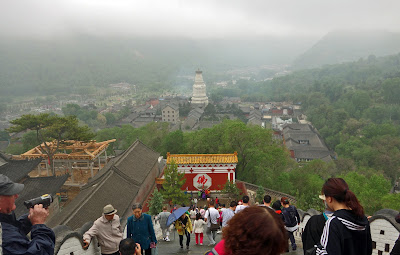MOUNT WUTAI SHAN (GYANAK RIWO TSE NGA ) Birth place of Manjushree
 |
| Mount Wutai Shan; Birth place of Manjushree |
 |
| Manjushree (Jamphel Yang) |
The bodhisattva is believed to frequently appear on the
mountain, taking the form of ordinary pilgrims, monks, or most often unusual
five-colored clouds. Its five grass covered flat peaks are arranged in a
crescent-shaped configuration and are located above the tree-line around 3,000
m. Accordingly, the mountain obtained its name Wutai Shan, the Five-Terrace
Mountain.
Tibetans and Mongols referred to it as Gyanak (tib. China) Riwo Tse Nga, the Five-Peaked Mountain of China.
The mountain peaks appear from the far distance like heavenly altars and are
conventionally referred to by their cardinal directions. Together the peaks are
believed to constitute Manjushri’s mandala with a different emanation of Manjushri
residing on each peak.
At the age of 20 years old, I could go to pilgrimage to Gyanak Riwo Tse Nga after visiting my
Monastery in Tibet and being able to spent one night at my monastery despite of
the current political problem was a blessing. The day I arrived at Gyanak Riwo Tse Nga, people out there
were celebrating the birthday of Manjushri and so many people have had gathered
from different parts of the world. The moment I arrived on Gyanak Riwo Tse Nga, when I saw those five peaks of mountain, the
feeling was overwhelming. Tears were rolling out spontaneously out of my eyes.
It was my first time that I felt responsibility being the Tulku of Simdha
Monastery and it was first time for the 20 years old boy then to experience the
connection to dharma which was so surreal yet so strong. You could still feel the
presence of Manjushri in those five peaks of mountain like the warmth of his
love and compassion. It was there I made the aspiration that I could go to all
the pilgrimage and since then I have had continue to cover as many of
pilgrimages around the world as possible. I am truly grateful that I have been
born with the privilege to practice the Buddha Dharma and be able to guide
others into it. I will try my best to share every moment with all of you and
hope to inspire some of you to go to some of the pilgrimages that I have been
to. I am just a guy with the bun with a tittle which I am also not sure but in
devotion to my guru Kyabje Mindrolling Trichen Rinpoche and His Holiness the 14th
Dalai Lama (yeshi norbu) who have entitled me with the name of Simdha Tulku and
faith in them, I want to try my best to carry on with the tittle I have been
shouldered with.
 |
| Mount Wutai Shan |
HISTORY
Since ancient times, Wutai Shan was known to be a mystical
and sacred site inhabited by divine spirits dwell, accompanied by unusual
events, such as miraculous light appearances at night, that can be seen up to
the present day. Thus it attracted pilgrims in search for spiritual
accomplishment.
In the ninth century Ch’eng-kuan (737-838), who was an
influential commentator of Buddhist scriptures, having resided for ten years at
Wutai Shan wrote:
“The splendid display of its resonant qualities fills the eyes and ears, and even so there are still more such excellent matters. Dragon palaces each in turn open up at night to a thousand moons. Fine and delicate grasses spread out in the mornings among hundreds of flowers. Sometimes there are ten thousand sages arrayed in space. Sometimes five coloured clouds are set firmly among the hill-gaps. Globes of light shine against the halcyon mountain. Auspicious birds soar in the hazy empyrean. One merely hears the name of the Great Sage Manjushri and no longer is beset by the cares of human existence.”
 |
| Maps of Mount Wutai Shan |
Once reaching the mountain, like the Chinese devotees the
foreign pilgrims experienced similar visionary encounter with Manjushri. The
fame of Wutai Shan had spread and thus influenced the writings of non-Chinese
Buddhist scriptures such as the Swayambhu Purana (Skt. Swayambhu Purāṇa), which
recounts the origin of Buddhism in the Kathmandu valley.
The biography contains another account of a certain shamen
called Ling Bian of the Later Wei dynasty who entered the Pure and Fresh
Monastery with the sutra on his head asking Mañjuśrī for help in the study of
the sutra. He later attained enlightenment. He also wrote 100 volumes of
commentaries on the sutra during his stay in the monastery.
Indian, Tibetan and Mongol Buddhist teachers were often well
respected by the Chinese court and thus granted a privileged position, which
allowed them to establish monasteries at Wutai Shan. This then led to the
establishment of a great diversity of monasteries and traditions at Wutai Shan.
By and large Buddhism thrived in Wu Tai Shan at present times.
Prayers to Manjushree : In Praise of Manjushree
Great Treasure of Blessing
Prayers to Manjushree : In Praise of Manjushree
Great Treasure of Blessing


Comments
Post a Comment